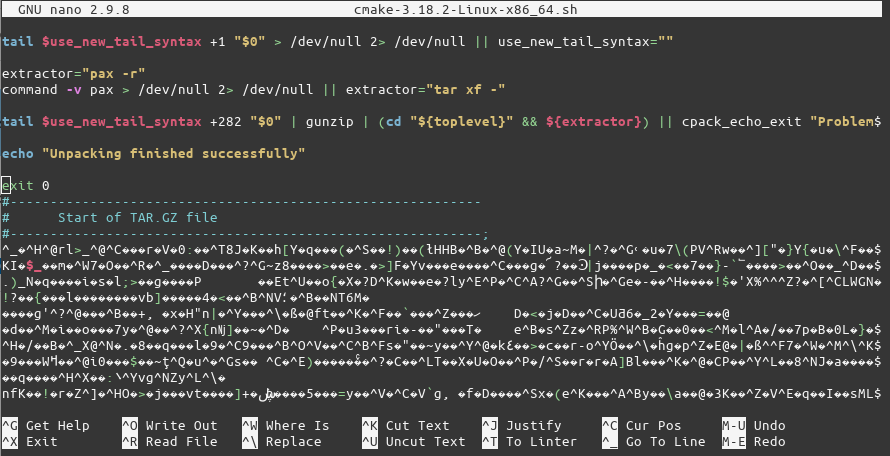In this article, we'll learn to install cmake on Linux. CMake is a cross-platform open-source meta-build system that can build, test, and package software.It can be used to support multiple native build environments including make in Linux/Unix, Apple's Xcode, and Microsoft Visual Studio. Download cmake-filesystem-3.11.4-3.el8.x8664.rpm for CentOS 8 from OKey repository.
You will find below generic recommendations for installing Amber20 as well as specific instructions tailored for your CentOS version.
Generic installation instructions
About cmake:
Since Amber20, a new installation mechanism is provided that makes use of cmake.A decent version of cmake is needed, therefore it is highly recommended to download andinstall the cmake executable from the cmake.org website.
About Python:
Many programs within Amber requires a decent version of Python.When configuring Amber, the run_cmake script will check your installationand will most probably recommend to download and install a compatible Pythonfrom Continuum IO (via miniconda). It is highly recommended to followthis suggestion and let the run_cmake script install Python inside the Ambertree.


About CentOS & MPI with Amber:
Some programs in Amber (e.g., pmemd, cpptraj, etc.) can be built and installed in their parallel MPI version.If you want to build and install these MPI programs, you will need to provide a MPI compiler like OpenMPI or MPICH.The OpenMPI and MPICH system installations provided by CentOS (i.e., through yum install) are known to be somehow incompatible with Amber20.
Our recommendation is to download a recent version of MPICH at mpich.org, untar the distribution in amber20_src/AmberTools/src,and executes in that directory the configure_mpich script.
Building with cmake
We highly recommend that you refer to Chapter 2 of the Amber 2020 Reference Manual for detailed instructions on how to install Amber20.
Since Amber20, the build system has move to cmake. A script called run_cmake is available in the amber20_src/builddirectory. For most users, the options chosen in this script should be OK.
Yum Install Cmake
The installation of Amber is performed in two steps: cmake configuration, then building and install:
cd amber20_src/build
# optional: edit the run_cmake script to make any needed changes;
# most users should not need to do this
./run_cmake
# Next, build and install the code:
make install
CentOS 8
The following command should get you all the necessary packages to get Amber to compile:
yum -y install tcsh make
gcc gcc-gfortran gcc-c++
which flex bison patch bc
libXt-devel libXext-devel
perl perl-ExtUtils-MakeMaker util-linux wget
bzip2 bzip2-devel zlib-devel tarCentOS 7
The following command should get you all the necessary packages to get Amber to compile:
yum -y install tcsh make
gcc gcc-gfortran gcc-c++
which flex bison patch bc
libXt-devel libXext-devel
perl perl-ExtUtils-MakeMaker util-linux wget
bzip2 bzip2-devel zlib-devel tarCentOS 6
Installation of Amber on a CentOS 6 Linux node is a little tricky since the default GNU compileris now too old to compile the source code. The recommended procedure is to install a more recent versionusing the Developer Toolset software collection(devtoolset).
yum -y install tcsh make
which flex bison patch bc
libXt-devel libXext-devel
perl perl-ExtUtils-MakeMaker util-linux wget
bzip2 bzip2-devel zlib-devel tar
# update to a newer gcc
yum -y install centos-release-scl
yum -y install devtoolset-8
then, in your terminal, access the newer GNU compiler using:
Install Cmake 3.5 Centos


About CentOS & MPI with Amber:
Some programs in Amber (e.g., pmemd, cpptraj, etc.) can be built and installed in their parallel MPI version.If you want to build and install these MPI programs, you will need to provide a MPI compiler like OpenMPI or MPICH.The OpenMPI and MPICH system installations provided by CentOS (i.e., through yum install) are known to be somehow incompatible with Amber20.
Our recommendation is to download a recent version of MPICH at mpich.org, untar the distribution in amber20_src/AmberTools/src,and executes in that directory the configure_mpich script.
Building with cmake
We highly recommend that you refer to Chapter 2 of the Amber 2020 Reference Manual for detailed instructions on how to install Amber20.
Since Amber20, the build system has move to cmake. A script called run_cmake is available in the amber20_src/builddirectory. For most users, the options chosen in this script should be OK.
Yum Install Cmake
The installation of Amber is performed in two steps: cmake configuration, then building and install:
cd amber20_src/build
# optional: edit the run_cmake script to make any needed changes;
# most users should not need to do this
./run_cmake
# Next, build and install the code:
make install
CentOS 8
The following command should get you all the necessary packages to get Amber to compile:
yum -y install tcsh make
gcc gcc-gfortran gcc-c++
which flex bison patch bc
libXt-devel libXext-devel
perl perl-ExtUtils-MakeMaker util-linux wget
bzip2 bzip2-devel zlib-devel tarCentOS 7
The following command should get you all the necessary packages to get Amber to compile:
yum -y install tcsh make
gcc gcc-gfortran gcc-c++
which flex bison patch bc
libXt-devel libXext-devel
perl perl-ExtUtils-MakeMaker util-linux wget
bzip2 bzip2-devel zlib-devel tarCentOS 6
Installation of Amber on a CentOS 6 Linux node is a little tricky since the default GNU compileris now too old to compile the source code. The recommended procedure is to install a more recent versionusing the Developer Toolset software collection(devtoolset).
yum -y install tcsh make
which flex bison patch bc
libXt-devel libXext-devel
perl perl-ExtUtils-MakeMaker util-linux wget
bzip2 bzip2-devel zlib-devel tar
# update to a newer gcc
yum -y install centos-release-scl
yum -y install devtoolset-8
then, in your terminal, access the newer GNU compiler using:
Install Cmake 3.5 Centos
How To Install Cmake Centos
source /opt/rh/devtoolset-8/enable